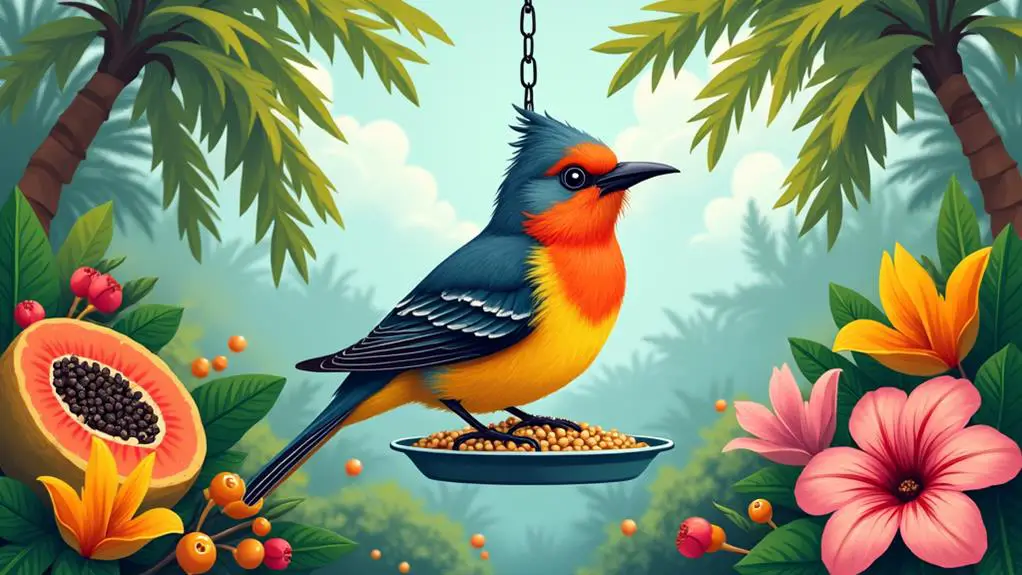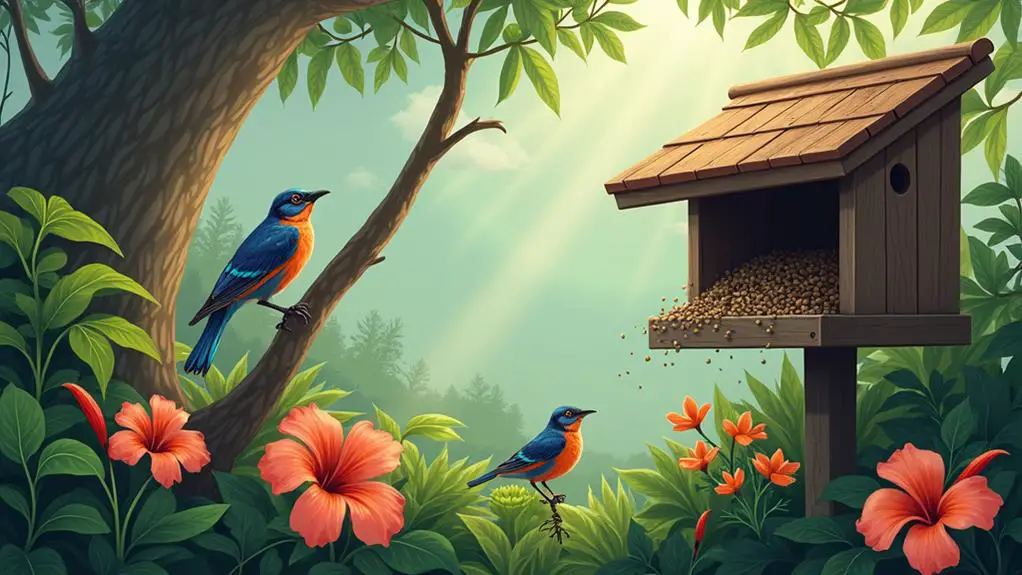When you’re trying to attract finches to Hawaii’s ecosystem, you’re taking on a challenging task. Native finches have declined drastically in the past century due to habitat loss, invasive species, and disease. To attract finches, you’ll need to provide them with the right food sources, such as Nyjer seeds and sunflower seeds. However, that’s just the beginning – you’ll also need to create finch-friendly habitats and provide the necessary shelter. The question is, what else can you do to entice these birds and help them finches in Hawaii’s unique ecosystem, and what steps should you take first?
Key Takeaways
- Offer a variety of seed types, including Nyjer seeds and sunflower seeds, to attract finches to Hawaii’s ecosystem.
- Incorporate native plants, such as ilima, hibiscus, and plumeria, to provide necessary resources for finch survival.
- Create a mix of open and dense areas with native grasses, shrubs, and trees to cater to different finch species.
- Provide shallow, freshwater sources like birdbaths or small ponds for finch watering and sheltered water sources.
- Install finch nesting boxes in suitable locations, mimicking natural nesting sites, to provide shelter from harsh weather conditions.
Finch-Friendly Food Sources

To attract finches to Hawaii, you’ll need to provide them with suitable food sources.
Finches primarily consume seeds, so offering a variety of seed types is essential. You can choose from different seed varieties, such as nyjer seeds, sunflower seeds, and millet seeds. Nyjer seeds are high in oil and calories, making them an excellent choice for finches.
Sunflower seeds, on the other hand, are rich in fat and protein.
When selecting bird feeders, consider the type of seed you’re offering. Tube feeders are ideal for nyjer seeds, while hopper feeders are better suited for sunflower seeds. Ensure the feeders are designed with finches in mind, featuring small perches and openings that allow them to easily access the seeds.
You can also offer fresh fruits, such as papaya or orange slices, to supplement their diet. By providing a diverse range of seed varieties and using the right bird feeders, you’ll be able to attract finches to your Hawaiian location.
Regularly cleaning and refilling the feeders will also help maintain a healthy and welcoming environment for these birds.
Creating Finch Habitats
By providing finches with suitable food sources, you’ve taken the first step in creating a welcoming environment for these birds in Hawaii.
However, finches also require a habitat that provides the necessary conditions for foraging, roosting, and breeding.
Creating finch habitats involves incorporating various native plants and structures that offer a range of resources and shelter.
Incorporating plants with diverse structures and densities is crucial for maintaining habitat diversity.
Consider planting native grasses, shrubs, and trees that offer berries, seeds, and insects.
Finch watering is also an essential aspect of habitat creation.
Installing shallow, freshwater sources such as birdbaths or small ponds will provide finches with the necessary water for drinking and bathing.
Maintaining a mix of open and dense areas will cater to different finch species and their preferences.
You can create this mix by varying the density of vegetation, using plants with different growth habits, and incorporating features such as rocks and logs.
Providing Finch Shelter

Within their habitats, finches require shelter from harsh weather conditions, predators, and extreme temperatures.
You can provide finches with shelter by installing finch nesting boxes in suitable locations. These boxes should be designed to mimic the natural nesting sites of finches, such as tree cavities or rock crevices. The boxes should have a small entrance hole, a depth of about 6-8 inches, and a floor area of approximately 6-8 square inches.
When installing finch nesting boxes, consider the orientation and placement to ensure they receive the right amount of sunlight and protection from the elements.
You should also ensure that the boxes are installed at a height that’s inaccessible to predators, such as cats and rats. Additionally, providing sheltered water sources is crucial for finches.
You can create sheltered water sources by placing a birdbath or a shallow dish in a location that’s protected from strong winds and predators. This will provide finches with a safe place to drink and bathe.
Finch Attracting Plants
Finches in Hawaii often forage for seeds, nectar, and insects among the island’s native flora.
You can create an inviting environment for finches by incorporating native blooms into your garden or landscape. Native plants like ilima, hibiscus, and plumeria serve as finch magnets, providing the necessary resources for survival.
When selecting plants, consider species that produce seeds or nectar, as these will attract finches.
For example, the akeake tree produces nectar-rich flowers that finches find irresistible. You can also plant grasses and shrubs that provide seeds, such as the native pili grass.
To maximize the effectiveness of your finch-attracting plants, consider the following factors.
Plant native species in clusters or groups, as this will create a more natural environment. Also, choose plants that bloom at different times to provide a constant source of food throughout the year.
Maintaining Finch Populations

Maintaining Finch Populations
Effective population management requires attention to finches’ social dynamics, behavior, and health.
You’ll need to implement finch tracking methods to monitor their movement patterns, foraging habits, and breeding behaviors. This information will help you identify potential threats to the population and develop strategies to mitigate them.
Population monitoring is crucial in maintaining a healthy finch population.
You can use techniques such as mark-release-recapture, banding, and radio telemetry to track individual finches and monitor population trends. These methods will provide you with data on population size, structure, and dynamics, allowing you to make informed decisions about conservation efforts.
Regular monitoring of finch populations will also help you detect early signs of disease, parasites, or other health issues.
FAQs: Finches in Hawaii
Can Finches Be Kept as Pets in Hawaii?
You can keep finches as pets in Hawaii, but it requires proper Finch care and a well-designed Cage design to mimic their natural habitat, ensuring a healthy environment with adequate space, ventilation, and social interaction.
How Do Finches Impact Hawaii’s Native Bird Species?
You envision Hawaii’s lush forests, teeming with native birds, but finches disrupt this balance. They compete for food, depleting resources, and displace native birds from their nests, exacerbating population decline through food competition and nesting displacement.
Are Finches Susceptible to Hawaiian Diseases?
You’ll find that finches, like other introduced bird species, may possess varying levels of disease resistance, depending on their immune system’s ability to adapt to new pathogens, potentially influencing their susceptibility to local diseases.
Can Finches Be Introduced to Hawaii’s Islands Naturally?
You’re considering introducing finches to Hawaii naturally. Island hopping via wind currents is theoretically possible, but unlikely, as finches aren’t typically adept at long-distance oceanic dispersal, and wind patterns may not facilitate such migration.
Do Finches Contribute to Hawaii’s Seed Dispersal Process?
You examine the role of finches in seed dispersal, observing their behavior of consuming fruits and subsequently depositing seeds, often in new locations, thereby facilitating seed dispersal, which is a crucial ecological process.
Conclusion: Finches in Hawaii
By incorporating finch-friendly food sources, you can attract these birds to Hawaii’s ecosystem, but it’s not just about offering seeds. Creating a balanced environment that provides shelter, open spaces, and native plants is crucial. On one hand, tube feeders filled with Nyjer seeds can be a magnet for finches, but on the other, a landscape devoid of native grasses and shrubs can be a deterrent. Strike a balance to support thriving finch populations.













